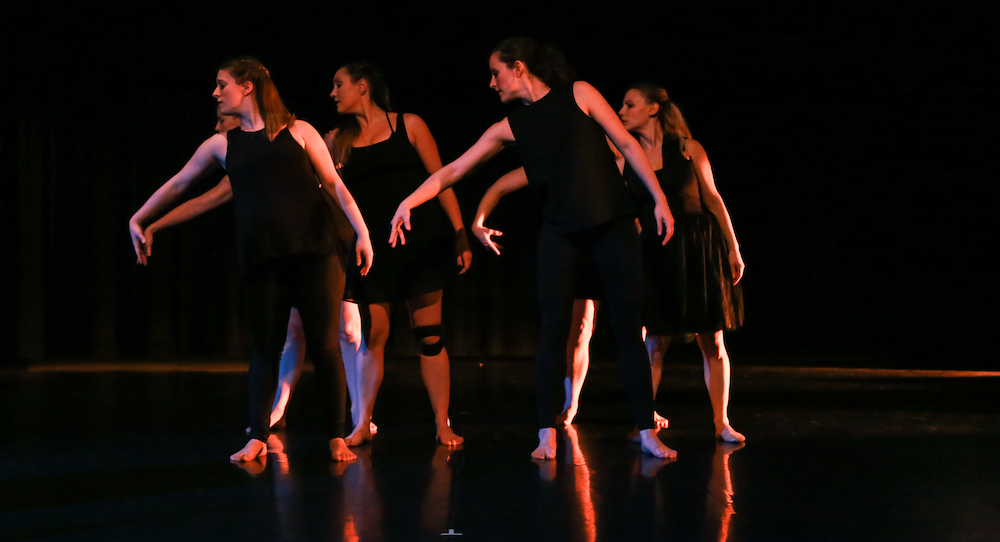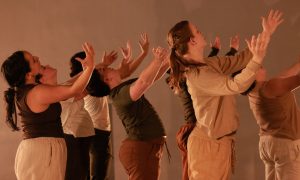There’s just something about dancing in the glow of stage lights, of giving your all to an audience with something on which you’ve worked hard (for weeks, months or even years). The process of getting there, of developing a work of dance art with people who become like family, can be just as special. For youth and young adults, dance studios, schools and other after-school programs can offer these spaces. For adults, once leaving higher education, the majority of performance opportunities are in the professional realm — that is, wherein one is being paid to perform. Amateur opportunities (meaning for which one is not paid, not as any indication of capability) seem all too rare.
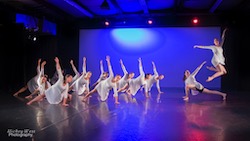
Nozama Dance Collective. Photo by Mickey West Photography.
Yet the spaces that offer these opportunities make a true impact in the lives of dancers, audience members and those in local communities. Dance Informa speaks with three dance professionals who offer such spaces — Gracie Novikoff, artistic director of Nozama Dance Collective (Boston, MA); Brenna Banister, artistic director of Alive Dance Collective (also Boston, MA); Kat Wildish, director of internationally-hosted ballet workshops and dance intensives for adults that culminate in performances (as well as NYC real theater performance showcases for small companies and dancers of all ages).
Novikoff says that her company “creates and performs work pertaining to the female experience in a particular sociopolitical context,” as well as “reveals the empowered woman who doesn’t always know she’s there.” Novikoff believes that when presenting work on controversial topics, dancers perform with “raw emotion that inspires people to relate and opens up dialogue” on the issue in question. “We aim to make dance accessible, even exciting, to the kinds of people who don’t normally see dance,” she explains. As a feedback method toward this goal, the company gathers — and then implements — feedback from cards audiences members fill out at performances.
Additionally, both parts of this mission are particularly relevant to the kind of women who dance in her company — out there working in various fields or in school, while also engaging in artmaking on those experiences. In this artmaking, they have conversations about what it’s like to be a woman in the places their lives play out. All along, Novikoff works at this creation along with her full-time job — as do most of the women in the company (some have multiple jobs and/or are going to school, as well).
She asserts that she never meant the company to be anything more than “supplemental to other work that I do.” Novikoff adds that she can see how her creative work with the company enhances her work as a pediatric nurse, and vice-versa. “They feed each other!” she claims. It’s similar, as far as she can see, with dancers in the company and the work that they do outside of the company.
Because of the demands of full-time (sometimes plus) work and/or school, not to mention the typical family and personal obligations, Novikoff exercises flexibility, patience and understanding with her dancers’ packed schedules and instances of relocating or travel. For instance, she’s had dancers tell her they really need a “mental health night” and can’t come to rehearsal. She explains how as long as dancers are clear and up-front with her, she does want them to do what they need to in those situations.
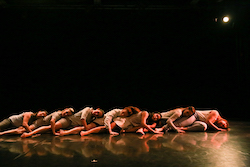
Alive Dance Collective. Photo by Olivia Moon Photography.
She’s had other dancers travel into Boston from New York City to rehearse on certain weekends and perform. Another has spent part of the year in Chicago. She explains how video of choreography, that dancers in other locations can learn on their own time, can be incredibly helpful in these sorts of situations. “I never want to hear one of my dancers say that they don’t have time to be involved, so we do what we can to make it work for all of them,” she asserts.
Banister also emphasizes how her dancers come from all different fields — from dentistry to education to nursing — and thus bring all types of perspectives to the creative work.
They also bring all sorts of other connections. First, they bring friends and colleagues in their separate professional spheres to the shows, and from that make new dance lovers. “I’ve heard people at shows say things like, ‘I’ve never been to a dance show before, but that was so cool,’ and ‘I’m so glad [so and so] invited me. I can’t wait to come back!’” explains Banister.
Second, they bring connections to local organizations for which Alive Dance Collective has raised funds at their shows — including Art Relief (a community art therapy site in Watertown, MA) and You Care, We Care (a non-profit organization for children in need internationally). “We’ve been really lucky to have support from different bases to pull from,” Banister says.
Working with busy professionals is not always easy, she explains. Just like Novikoff, she, and all in the company, have to have a lot of flexibility and adaptability. For instance, there are periods when certain dancers just have too much going on to be part of the company. The company ranges from six to 10 dancers. Sometimes things also just come up in people’s lives.
Consequently, there’s a good deal of restaging that has to happen, sometimes at the last minute. Banister also has to be flexible with when pieces are ready. Dancers work on certain pieces to present, and if the dancers say they’re not ready to perform them, then they’ll just present the next time they perform. “We’re serious about what we do,” Banister asserts, “but we’re not professionals; we’re doing this for enjoyment.”
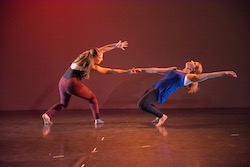
Nozama Dance Collective. Photo by Mickey West Photography.
Banister acknowledges something else significant that she’s seen with her company and herself — with aging, a deepening of artistry even as physical virtuosity may fade. “We all say that we understand our body better now than we did in high school. I maybe had more flexibility and could do more pirouettes, but I’m a better dancer [now] because I know how to use the technique that I have,” she says. Like Novikoff, Banister is intentional about making dancers feel welcome and nurtured in the company. “Being able to delve into material that’s personal is an important part of our group, so we really strive to make it a safe space that’s supportive,” she shares.
Wildish, a former New York City Ballet and American Ballet Theatre dancer, has been teaching for over 40 years. She discusses other unique aspects of teaching adult amateur dancers. For instance, the adult brain isn’t fully developed until around age 25, so the way adults learn technique and choreography is different from the way youth (children, teens and young adults) do. “That’s what I do, that’s how I teach,” she asserts. Banister also teaches dance, and affirms this difference between working with adults and working with youth.
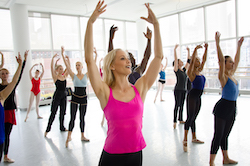
Kat Wildish teaching an adult ballet class. Photo by Kyle Froman.
Wildish has developed a syllabus for this kind of teaching, which she offers in New York City, around the U.S., and internationally — in Italy, Brazil and Spain, to name a few. In addition to technique and stage presence, the syllabus includes the conditioning that adults often need in order to dance at their best, particularly in the core and in the arms. In delivering this teaching, she challenges her students; Wildish believes that all too often dance teaching for adults is “dumbed down,” which is “not fun” to experience if you’re a student. “Adult students don’t need baby steps,” she says. “They can learn several counts of eight. They might make some mistakes, but they can do it!” She stops short of calling her curriculum a methodology, as it’s not quite as formalized as the RAD or SAB methodology.
In addition to open classes and university classes, Wildish most often offers this teaching in one-week workshops that culminate in performances. These performances started in the basement of Broadway Dance Center, and have since been held at The Danny Kaye Playhouse and the Salvatore Capezio Theater at Peridance, among other venues. There was a bit of initial apprehension to her adult amateur students performing at such grand professional venues. Yet Wildish believed in her students and in her vision, and convinced those in charge.
That believing in dancers and vision seems to be true of all three of these performing arts leaders. They know that adult amateur dancers have a lot to offer, and deserve a chance to perform just as much as youth and professionals do. It only takes persistence, creativity with resources and adaptability. Given these offerings, amateur adult dancers can shine to the last seats in the house and beyond.
By Kathryn Boland of Dance Informa.


